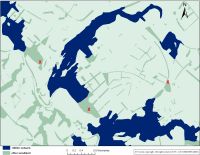Summary
Background
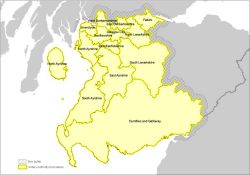
The study area, defined by the Unitary Authority boundaries (see map on right) with a 5 km buffer applied to the external boundary, is approximately 1.5 million hectares (20,200ha of the area is in England).
The following UK Biodiversity Action Plan (BAP) priority woodland types occur in south west Scotland:
- Upland mixed ash woodland
- Upland oak woodland
- Wet woodland
- Upland birch woodland
- Lowland mixed broadleaved woodland.
The river, gorge and riparian networks contain the main wooded areas of the Clyde Valley, whilst Dumfries & Galloway contains important examples of old sessile oak woodland and Tilio-Acerion forest.
This study focused on the broadleaved woodland components as the priority woodland habitats for the conservation of woodland biodiversity within the context of the wider forest landscape.
Objectives
In south west Scotland, identify:
- The quantity, size and location of broadleaved woodland specialist networks
- The quantity, size and location of high quality broadleaved woodland specialist networks
- Species rely on these networks
- The constraints to woodland expansion.
Methods
- Experts were asked to evaluate individual woodland blocks by broadly assessing the woodland structure, deadwood and field layer components, to enable a biodiversity quality classification to be made for each block.
- The Habitat Network Tool from BEETLE (Biological and Environmental Evaluation Tools for Landscape Ecology) was used to group woodlands that share several habitat characteristics, and to model the dispersal permeability of all the non-habitat land-cover components of the matrix.
- In view of the priority habitats of south west Scotland, the focus was the range of broadleaf woodland specialist focal species considered as moderately mobile, not sensitive to habitat patch size, and sensitive to woodland edge.
- Core areas of broadleaved woodland were identified in a GIS using the Scottish Semi-natural Woodland Inventory (SSNWI) and National Inventory of Woodland and Trees (NIWT) data to produce polygons of contiguous areas of woodland identified as having an 80% or more broadleaved component and a 50% or more canopy cover.
- A 50 m woodland edge was removed from the core habitat areas where the habitat did not connect with other woodland. The woodland edge was added to the non-habitat matrix with a permeability value of 1 (low value equal highly permeable).
Results
Forest Habitat Networks Scotland – SW Scotland report (PDF-661K)
Broadleaved woodland networks of high biodiversity quality were identified:
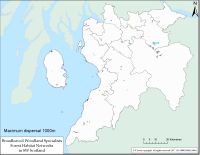
The results indicate opportunities for woodland improvement when laid above non-qualified broadleaved woodland networks:
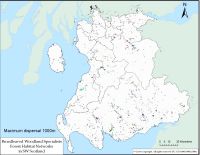
Examples of how network connectivity can be improved
Improving the biodiversity quality of existing woodland:
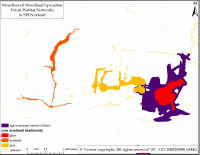
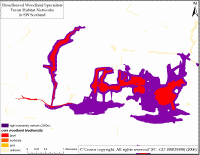
Adding new woodland in the areas shown:
